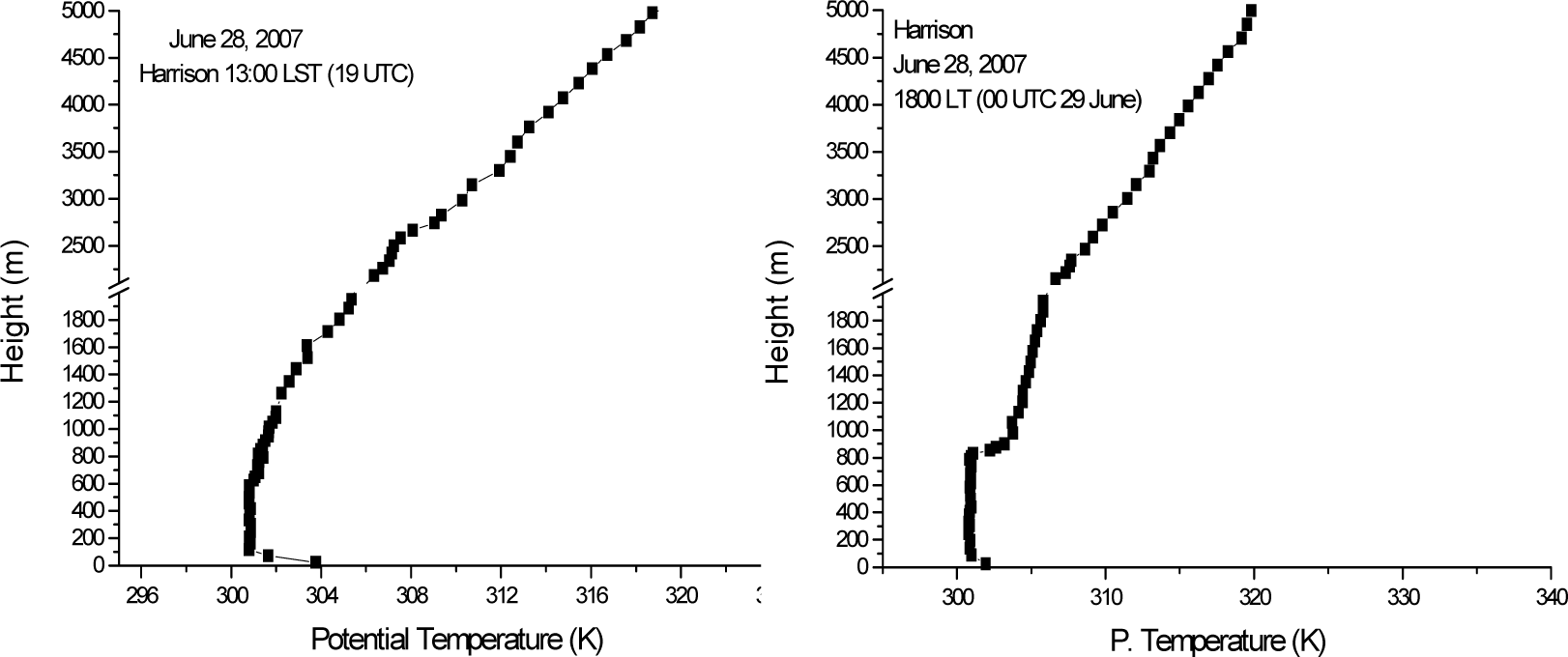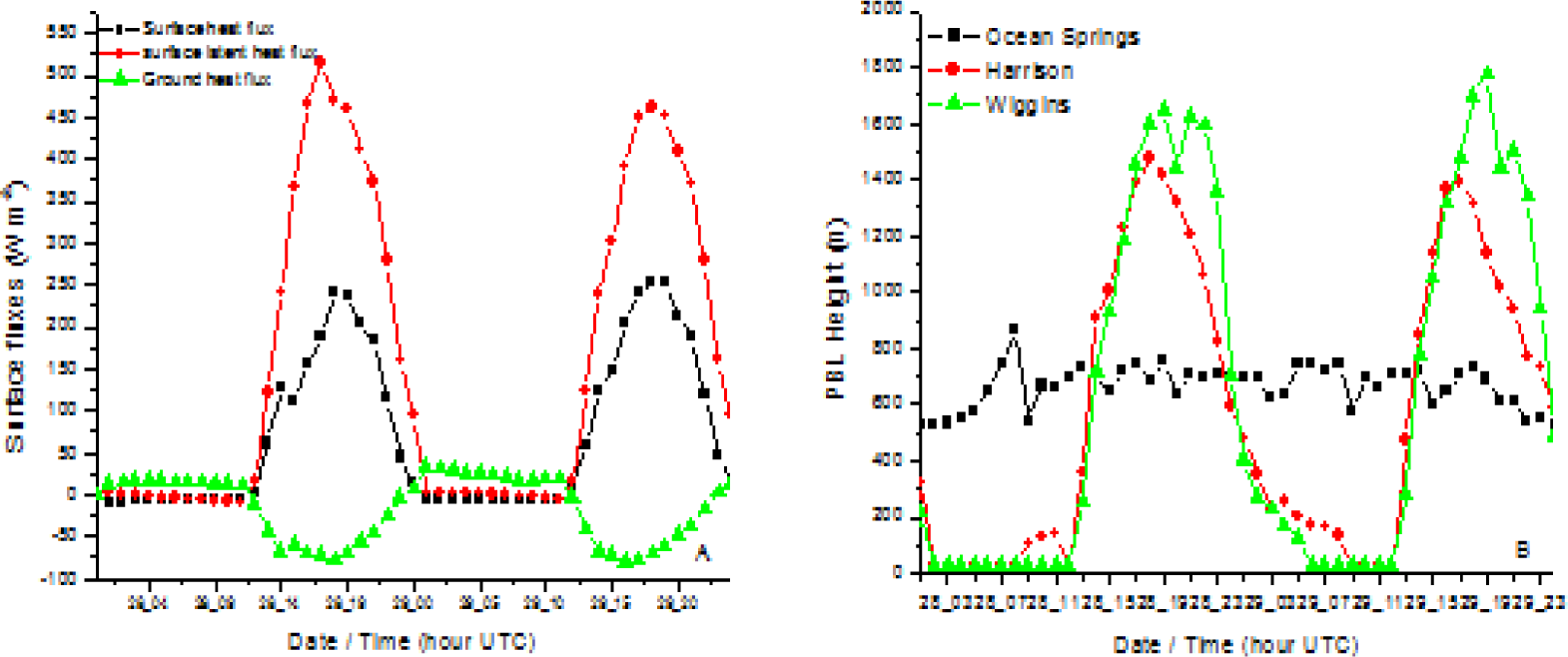Some Observational and Modeling Studies of the Atmospheric Boundary Layer at Mississippi Gulf Coast for Air Pollution Dispersion Assessment
Abstract
:Introduction
Brief Description of the Experiment
Location of Experiment
Equipment Used
Brief Description of the Modeling Aspects
Mesoscale Atmospheric Model
Dispersion Model
Model Domains and Initialization
Dispersion Simulation
Results
Synoptic Meteorological Conditions
Wind and Temperature Profiles from GPS Sonde
Diurnal Variation in Surface Layer Parameters
Meteorological Model Results
Horizontal Flow Field
Vertical Cross-Section of Simulated Variables
Dispersion Simulation Results
Simulated Air Mass Trajectories and Particle Positions
Plume Distribution
Summary and Conclusions



















| Dynamics | Primitive equation, non-hydrostatic | ||
|---|---|---|---|
| Vertical resolution | 32 levels | ||
| Domains | Domain1 | Domain2 | Domain3 |
| Horizontal resolution | 36 km | 12 km | 4 km |
| Grid points | 54 × 40 | 109 × 76 | 187 × 118 |
| Domains of integration | 93.0 W – 78.05 W | 91.74 W – 81.92 W | 90.28 W – 84.77 W |
| 27.16 N – 34.45 N | 28.5 N – 34.45 N | 29.38 N – 32.54 N | |
| Radiation | Dudhia (1989) scheme for short wave radiation, Rapid radiative transfer model (RRTM) for long wave radiation | ||
| Surface processes | Noah Land surface model | ||
| Boundary layer | Yonsei State University (YSU) PBL scheme | ||
| Initial, boundary conditions, Sea surface temperature | NCEP FNL analysis data | ||
| Convection | Kain and Fritsch (1993) scheme on the outer grids domain1, domain2 | ||
| Explicit moisture | WSM3 class simple ice (SI) scheme | ||
| Location | Stack Ht(m) | Stack Diameter Ds (m) | SO2 | CO | NOX |
|---|---|---|---|---|---|
| Gulfport | 115.1 | 3.85 | 11280.8 | 7021.1 | 285.5 |
| Pascagoula | 54.1 | 1.35 | 1742.8 | 1367.6 | 32.4 |
| Escatawpa | 105.0 | 10.23 | 12522.2 | 4742.9 | 299.1 |
| Passchritian | 45.0 | 3.0 | 1270.53 | 565.6 | 3263.5 |
| Grid Centre | 30.5 N, -89.5 L |
|---|---|
| Vertical resolution | 7 Levels – 50, 100, 200, 500, 1000,2000, 5000 |
| Horizontal Grid | 2 × 2 degree |
| Horizontal resolution | 0.01 × 0.01 |
| Turbulence Method | Standard Velocity Deformation, Vertical diffusivity |
| Meteorology | WRF Simulated hourly meteorological fields |
| Number of release particles per cycle | 500 |
Acknowledgments
References
- Garratt, JR. The Atmospheric Boundary-Layer; Cambridge University Press: UK, 1992; pp. 1–316. [Google Scholar]
- Liu, H; Chan, JCL; Chang, AYS. Internal boundary layer structure under sea-breeze conditions in Hong Kong. Atmos. Env 2001, 35, 683–692. [Google Scholar]
- Luhar, AK. An analytical slab model for the growth of the coastal thermal internal boundary layer under near-neutral onshore flow conditions. Bound. Layer. Meteor. 1998, 88, 103–120. [Google Scholar]
- Stull, RB. An Introduction to Boundary Layer Meteorology; Kluwer Academic Publishers: Dordrecht, 1988; p. 666. [Google Scholar]
- Boybeyi, Z. Sethu Raman.: Numerical Investigation of Possible Role of Local Meteorology in Bhopal Gas Accident. Atmos. Env 1995, 29(4), 479–496. [Google Scholar]
- Pielke, RA; McNider, RT; Moran, MD; Moon, DA; Stocker, RA; Walko, RL; Uliasz, M. Regional and mesoscale meteorological modeling as applied to air quality studies. In Air Pollution Modeling and Its Application. VII; Van Dop, H, Steyn, DG, Eds.; Plenum Press, 1991; pp. 259–290. [Google Scholar]
- Pielke, RA; McNider, RT; Segal, M; Mahrer, Y. The use of a mesoscale numerical model for evaluations of pollutant transport and diffusion in coastal regions and over irregular terrain. Bull. Amer. Met. Soc 1983, 64, 243–249. [Google Scholar]
- Jin, H; Raman, S. Dispersion of an elevated release in a coastal region. J. Appl. Meteor. 1996, 35, 1611–1624. [Google Scholar]
- Kotroni, V; Kallos, G; Lagouvardos, K; Varinou, M; Walko, R. Numerical simulations of the meteorological and dispersion conditions during an air pollution episode over Ahtens, Greece. J. Appl. Meteor. 1999, 38, 432–447. [Google Scholar]
- Lu, R; Turco, RP. Air Pollutant transport in a coastal environment II. Three-dimensional simulations over Los Angeles Basin. Atmos. Env. 1995, 29, 1499–1518. [Google Scholar]
- Monti, P; Leuzzi, G. A numerical study of mesoscale airflow and dispersion over coastal complex terrain. Int. J. Environ. and Poll 2005, 25(1), 239–250. [Google Scholar]
- Uliasz, M. The Atmospheric Mesoscale Dispersion Modeling System. J. Appl. Meteor 1993, 32, 139–149. [Google Scholar]
- Segal, M; Pielke, RA; Arritt, RW; Moran, MD; Yu, CH; Henderson, D. Application of a mesoscale atmospheric dispersion modeling system to the estimation of SO2 concentrations from major elevated sources in southern Florida. Atmos. Env. 1988, 22(7), 1319–1334. [Google Scholar]
- Physick, WL; Abbs, DJ. Flow and Plume Dispersion in a Coastal Valley. J. Appl. Meteor 1992, 31, 64–73. [Google Scholar]
- Liu, H; Chan, JCL. An investigation of air-pollutant patterns under sea-land breezes during a severe air-pollution episode in Hong Kong. Atmos. Env 2002, 36, 591–601. [Google Scholar]
- Liu, H; Chan, JCL. Boundary layer dynamics associated with a severe air-pollution episode in Hong Kong. Atmos. Env. 2002, 36, 2013–2025. [Google Scholar]
- Ohashi, Y; Kida, H. Local circulations developed in the vicinity of both coastal and inland urban areas: A numerical study with a mesoscale atmospheric model. J. Appl. Meteor. 2002, 41, 30–45. [Google Scholar]
- Harris, L; Kotamarti, VR. The characteristics of the Chicago Lake Breeze and its effects on Trace Particle transport: Results from an episodic event simulation. J. Appl. Meteor 2005, 44(11), 1637–1654. [Google Scholar]
- Skamarock, WC; Klemp, J; Dudhia, J; Gill, DO; Barker, DM; Wang, W; Powers, JG. A Description of the Advanced Research WRF Version 2. NCAR Technical Note, NCAR/TN-468+STR. Mesoscale and Microscale Meteorology Division; National Center for Atmospheric Research, Boulder: Colorado, USA, 2005; p. 113. [Google Scholar]
- Draxler, RR; Hess, GD. Description of the HYSPLIT_4 Modeling System. NOAA Technical Memorandum, ERL ARL-224. 1997; 1–25. [Google Scholar]
- Draxler, RR; Hess, GD. An overview of the Hysplit_4 modeling system for trajectories, dispersion and deposition. Aust. Meteor. Mag. 1998, 47, 295–308. [Google Scholar]
- Hong, S-Y; Noh, Y; Dudhia, J. A new vertical diffusion package with an explicit treatment of entrainment processes. Mon. Wea. Rev 2006, 134, 2318–2341. [Google Scholar]
- Dudhia, J. Numerical study of convection observed during the winter monsoon experiment using a mesoscale two-dimensional model. J. Atmos. Sci 1989, 46, 3077–3107. [Google Scholar]
- Mlawer, EJ; Taubman, SJ; Brown, PD; Iacono, MJ; Clough, SA. Radiative transfer for inhomogeneous atmosphere: RRTM, a validated correlated-k model for the long-wave. J. Geophys. Res 1997, 102(D14), 16663–16682. [Google Scholar]
- Hong, S–Y; Dudhia, J; Chen, S-H. A revised approach to Ice Microphysical Processes for the Bulk Parameterization of Clouds and Precipitation. Mon. Wea. Rev 2004, 132, 103–120. [Google Scholar]
- Kain, JS; Fritsch, JM. Convective parameterization for mesoscale models: The Kain-Fritsch scheme, the representation of cumulus convection in numerical models, K. A. Emanuel and D. J. Raymond, Eds. Amer. Meteor. Soc 1993, 1–246. [Google Scholar]
© 2008 MDPI All rights reserved.
Share and Cite
Yerramilli, A.; Challa, V.S.; Indracanti, J.; Dasari, H.; Baham, J.; Patrick, C.; Young, J.; Hughes, R.; White, L.D.; Hardy, M.G.; et al. Some Observational and Modeling Studies of the Atmospheric Boundary Layer at Mississippi Gulf Coast for Air Pollution Dispersion Assessment. Int. J. Environ. Res. Public Health 2008, 5, 484-497. https://doi.org/10.3390/ijerph5050484
Yerramilli A, Challa VS, Indracanti J, Dasari H, Baham J, Patrick C, Young J, Hughes R, White LD, Hardy MG, et al. Some Observational and Modeling Studies of the Atmospheric Boundary Layer at Mississippi Gulf Coast for Air Pollution Dispersion Assessment. International Journal of Environmental Research and Public Health. 2008; 5(5):484-497. https://doi.org/10.3390/ijerph5050484
Chicago/Turabian StyleYerramilli, Anjaneyulu, Venkata Srinivas Challa, Jayakumar Indracanti, Hariprasad Dasari, Julius Baham, Chuck Patrick, John Young, Robert Hughes, Lorren D. White, Mark G. Hardy, and et al. 2008. "Some Observational and Modeling Studies of the Atmospheric Boundary Layer at Mississippi Gulf Coast for Air Pollution Dispersion Assessment" International Journal of Environmental Research and Public Health 5, no. 5: 484-497. https://doi.org/10.3390/ijerph5050484
APA StyleYerramilli, A., Challa, V. S., Indracanti, J., Dasari, H., Baham, J., Patrick, C., Young, J., Hughes, R., White, L. D., Hardy, M. G., & Swanier, S. (2008). Some Observational and Modeling Studies of the Atmospheric Boundary Layer at Mississippi Gulf Coast for Air Pollution Dispersion Assessment. International Journal of Environmental Research and Public Health, 5(5), 484-497. https://doi.org/10.3390/ijerph5050484




